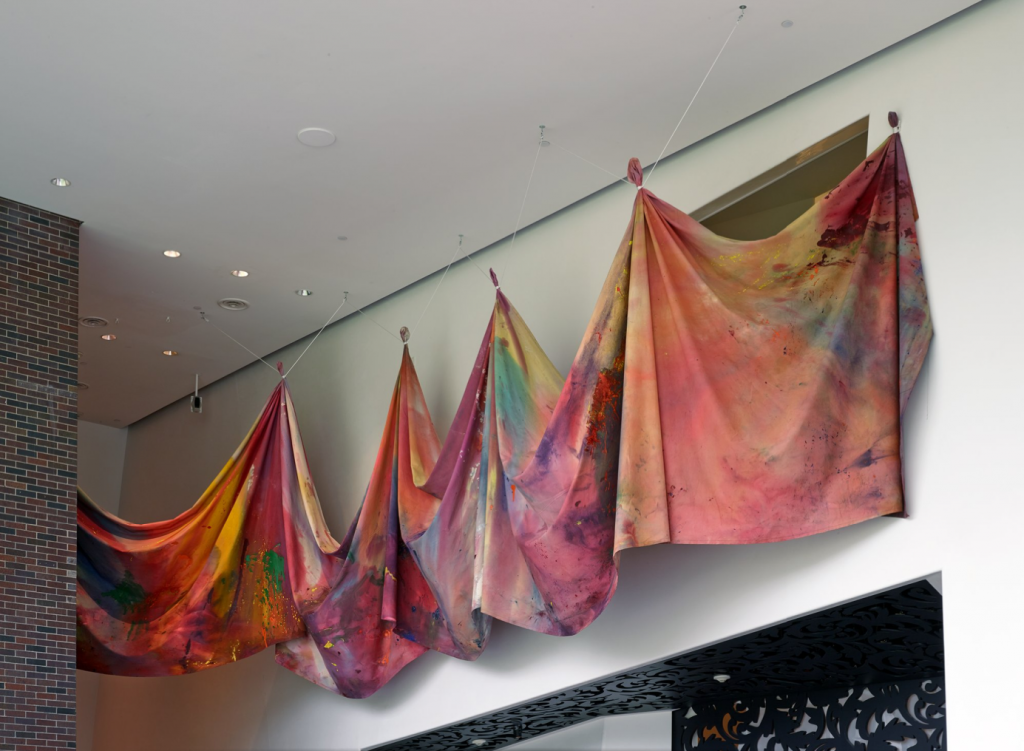
Sam Gilliam, Carousel Merge, 1971, installed at the Walker Art Center
“Even when artists of color are embraced by the canon,” says artist Rashid Johnson, “there is often a strict focus on a particular moment, rather than their career as a whole.” Such was the case with Sam Gilliam, the 81-year-old African American abstract artist whose “drape” paintings were widely celebrated in the 1960s and ’70s, but who has gone largely unnoticed since then. New interest in Gillian has led to several important shows of Gilliam’s early work, much of which represents important precursors to the “drape” paintings.
- A diplomatic thaw sends Iranian artists to the Frieze. Thanks to the ameliorated diplomatic relations between Iran and the West, and a “greater exchange of ideas and movement between artists [in Iran] and abroad,” Iranian contemporary artists are better able to participate in he international scene. This change seems most present in London, with the work of contemporary Iranian artists being exhibited at highly-visible forums such as the Frieze Art Fair.
- Qatar-based Syrian artist Waseem Marzouki creates multimedia “blueprints” of war, reflecting on the progression of the Syrian civil war. “When I see this painting after 10 years, if I’m still alive …I can remember everything that was happening and I can tell everything, without forgetting details.” Marzouki believes that when making art, artists can play a large role in preserving history. He says that, “when you make a series of paintings, or a painting, and you link this painting to what’s happening now, this [becomes] history.”
- Life of Ai? Ai Weiwei has signed a deal to write a memoir, which will be released in 2017. Ai’s book is anticipated to be “an extraordinary history of China over the past 100 years, told through the prism of both his own life story and that of his father, Ai Qing. In Ai’s eyes, totalitarianism represents the state’s “continuous attempts to destroy individual memories.”
- Online critic Paddy Johnson discusses the evolution of GIF art in advance of the pop-up exhibition Black Cube. Johnson notes that at their inception in the 1990s, GIFs were deeply rooted in the cultural tendency to link representations of digital space with those of outer space. By the early 2000s, the relationships of GIFs to online space had shifted. The continually increasing file-sharing capacity of social media enabled artists to easily share GIFs, perpetuating the feel-good phenomenon that was “net nostalgia.”
- “Punk house or parents’ house?” In his Tumblr project Hardcore Architecture, Marc Fischer illuminates an unexpected relationship between the punk scene and the suburban lifestyle. Fischer presents Google Street View images of a disparate array of residences–from picturesque suburban houses to grungy apartments, all the birthplaces (or at least the mailing addresses) of punk bands of the 1980s—from Acid Bath to Stench. Pairing the images with blurbs from the bands’ past reviews, Fischer achieves a “simple but revealing [result], touching on concerns ranging from architectural history to subculture and class.”
Follow Art News From Elsewhere on the Walker Art Center homepage or via @walkermag, the Walker’s editorial Twitter feed.



